The Northern hardwood and conifer macrogroup consists of the following habitats:
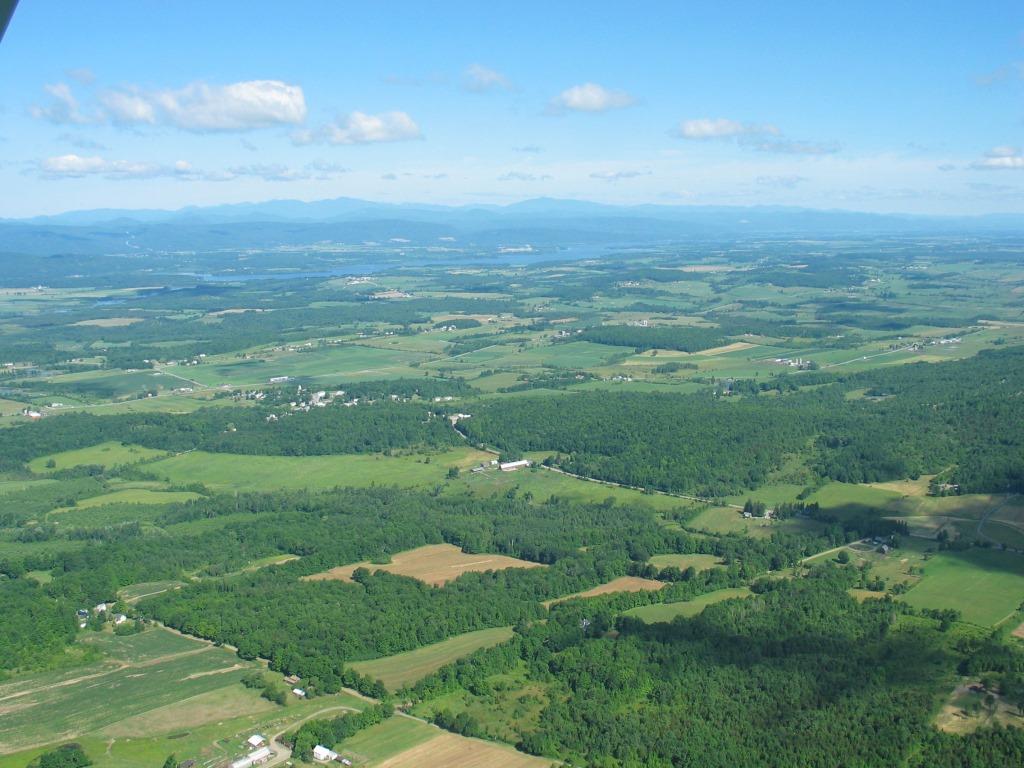
Laurentian-Acadian Red Oak-Northern Hardwood Forest
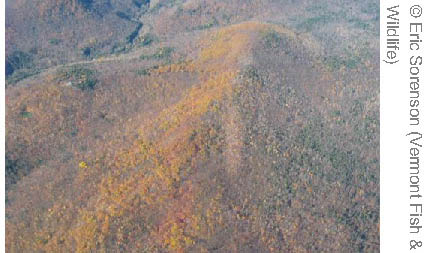

Regional distribution:
MA, ME, NH, NY, VT. 1,168,801 total acres of habitat, of which 19.2% is conserved.
Description:
A closed canopy forest of low to moderate moisture in which a significant component of red oak is present along with the normal suite of northern hardwoods, primarily sugar maple, beech, and yellow birch. Red maple, hemlock, and white pine are common associates. It is most common across the southern part of the northern hardwood forest's range, where it is transitional to oak or oak-pine forests, but also develops in warm, sunny locations in northern hardwood forest stands farther north. Diversity is lower than in most northern hardwoods; the shrub layer tends to be sparse, as is the fern and forb herb layer. Downslope movement of acorns from dry oaky ridges above may help account for persistence of this habitat type. These forests can be very productive on the best sites.
Download the
pdf for this habitat for information about species, crosswalks to state names, and condition of this habitat.
Laurentian-Acadian Pine-Hemlock-Hardwood Forest
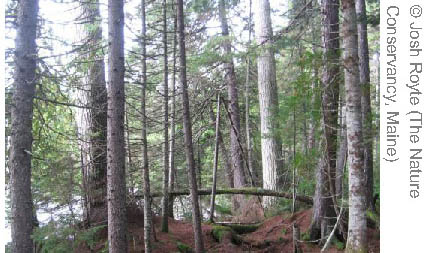

Regional distribution:
CT, MA, ME, NH, NY, PA, VT. 6,105,581 total acres of habitat, of which 15.0% is conserved.
Description:
A coniferous or mixed forest widespread in the glaciated northeast. White pine, hemlock, and red oak are typical canopy dominants. Red maple is common, and other hardwoods like sugar maple, beech, and birch also occur. Red spruce and balsam fir are uncommon associates, and oaks besides red oak are essentially absent from these forests. This forest system may be considered transitional between northern hardwood forests at higher elevations and to the north, and the warmer Appalachian hemlock- hardwoods and oak-pine forests at lower elevations and to the south. It ranges from the northeastern U.S. to adjacent Canada, and westward to the Great Lakes and upper Midwest. These forests are early and mid-successional in many areas, and often reflect an agricultural history.
Download the
pdf for this habitat for information about species, crosswalks to state names, and condition of this habitat.
Laurentian-Acadian Northern Pine-(Oak) Forest
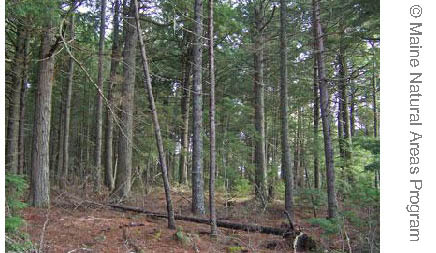

Regional distribution:
NY. 14,326 total acres of habitat, of which 3.8% is conserved.
Description:
A coniferous or mixed forest typically dominated by red pine and white pine. Codominants may include hardwoods such as red oak and red maple, with white birch and aspen in post- fire successional stands. Boreal conifers like spruce and fir may occasionally be present. Canopy structure is mostly closed but can be partially open; shrub and herb layers are generally of low diversity, and can be fairly dense to sparse. The center of the distribution of this dryish, mostly coniferous system is in the Great Lakes region; across New York and northern New England it tends to occur in patches in response to fire and poor soils.
Download the
pdf for this habitat for information about species, crosswalks to state names, and condition of this habitat.
Southern Atlantic Coastal Plain Mesic Hardwood Forest
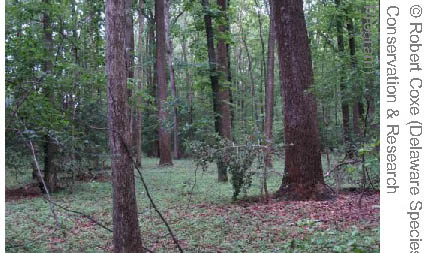

Regional distribution:
DC, DE, MD, NJ, PA, VA. 1,932,352 total acres of habitat, of which 12.1% is conserved.
Description:
A hardwood forest of the coastal plain with a significant component of mesophytic (moist but non-wetland) species, such as American beech or southern sugar maple. Upland and bottomland oaks at the mid range of moisture tolerance are usually also present, particularly white oak, but sometimes also southern red oak, cherrybark oak, or Shumard oak. Loblolly pine is sometimes present, but it is unclear if it is a natural component or has entered only as a result of past cutting. Understories are usually well- developed. Shrub and herb layers may be sparse or moderately dense. Ranging south from New Jersey to Georgia, these mostly large patch coastal plain forests occupy a variety of moist sites that are naturally sheltered from frequent fire.
Download the
pdf for this habitat for information about species, crosswalks to state names, and condition of this habitat.
Southern and Central Appalachian Cove Forest
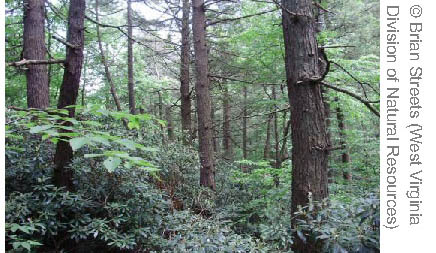

Regional distribution:
MD, VA, WV. 1,014,832 total acres of habitat, of which 33.0% is conserved.
Description:
A hardwood or mixed forest with a high diversity of mesophytic (moisture loving but non-wetland) trees. Canopy species commonly include yellow buckeye, sugar maple, white ash, basswood, tuliptree, cucumber tree, and American beech, sometimes in a single stand. Hemlock is sometimes present, mostly in acidic coves. Shrub and herb layers are similarly rich, and calcium-bearing and circumneutral bedrock tends to support the richest examples. This forest is typical of sheltered, shady places in the Blue Ridge and central Appalachian Mountains, forming large patches (tens to hundreds of acres) on concave slopes that accumulate nutrients and moisture. These are communities of high diversity and often great structural complexity.
Download the
pdf for this habitat for information about species, crosswalks to state names, and condition of this habitat.
South-Central Interior Mesophytic Forest
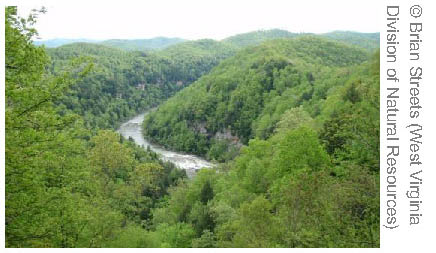

Regional distribution:
PA, VA, WV. 3,543,609 total acres of habitat, of which 4.4% is conserved.
Description:
A high-diversity, predominately hardwood forests that occurs on deep and enriched lowland soils or in somewhat protected landscape positions such as coves or lower slopes. Dominant species include sugar maple, beech, tuliptree, basswood, red oak, cucumber tree, and black walnut. Hemlock may be a component of some stands. Trees may grow very large in undisturbed areas. The herb layer is rich, often with abundant spring ephemerals. The core distribution of this system lies in the unglaciated Cumberland and Allegheny plateaus-- it occurs in our region only in the western and southern part.
Download the
pdf for this habitat for information about species, crosswalks to state names, and condition of this habitat.
Southern Piedmont Mesic Forest
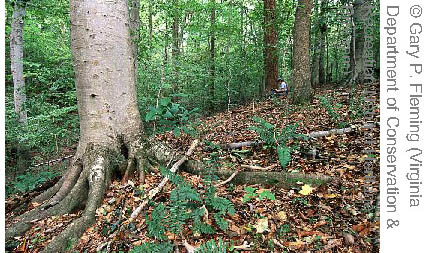

Regional distribution:
MD, VA. 2,438,858 total acres of habitat, of which 3.4% is conserved.
Description:
A hardwood forest of moist low or north-facing slopes in the Piedmont. Vegetation is dominated by trees that favor conditions of moderate moisture (sweetgum, white oak, red oak, tuliptree, basswood), with American beech most prominent. Conifers are occasionally abundant. A few places support dense heath shrubs; otherwise shrubs layers tend to be sparse to moderate. Rock chemistry is an important determinant of variation, with denser and more diverse herb layers on richer examples. This system is a prominent part of the ecological mosaic of the Piedmont down to Alabama and Georgia, and only the northernmost part of its range is in our region. It often follows along slopes in stream-dissected areas. Most examples are large patches of tens to hundreds of acres.
Download the
pdf for this habitat for information about species, crosswalks to state names, and condition of this habitat.
Southern Appalachian Northern Hardwood Forest
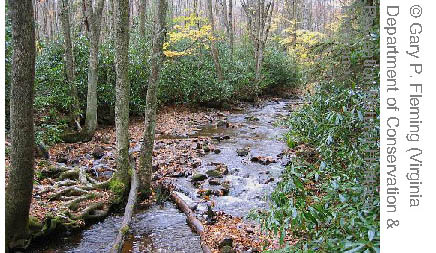

Regional distribution:
VA. 12,752 total acres of habitat, of which 90.9% is conserved.
Description:
A hardwood forest of high elevations in the southern Appalachians, dominated by various combinations of mesophytic northern hardwoods such as sugar maple, yellow birch, beech, and yellow buckeye. It is generally found above 4500 feet elevation, where cool and wet conditions are the most important ecological factor. Red oak-dominated stands in the same elevation zone are also included in this system. A dense herb layer is typical, as is a well-developed shrub layer. With its core distribution in the southern Appalachians, it occurs only on the highest peaks and ridges in the very southwestern part in our region, with the largest occurrence centered on Mount Rogers in Virginia. Included in this system are limited areas locally known as "beech gaps" and "boulderfields."
Download the
pdf for this habitat for information about species, crosswalks to state names, and condition of this habitat.
Northeastern Coastal and Interior Pine-Oak Forest
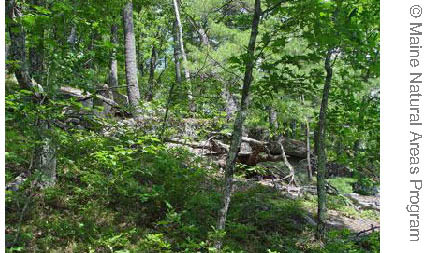

Regional distribution:
CT, MA, ME, NH, RI. 1,538,080 total acres of habitat, of which 15.8% is conserved.
Description:
A mixed forest dominated by white pine, red oak, and hemlock in varying proportions. Red maple and white and black oak are common associates, and northern hardwoods like white ash and American beech can appear as minor components. This forest of low to moderate moisture is usually closed canopy and can be heavily coniferous, with some nearly pure stands of white pine and red maple; hemlock is often more abundant in moister settings. This system type occurs over broad areas, but most of it is in early to mid-successional stages and heavily fragmented. It may well be that it is more widespread and abundant as a result of human occupation of and changes to the New England landscape.
Download the
pdf for this habitat for information about species, crosswalks to state names, and condition of this habitat.
North-Central Interior Beech-Maple Forest
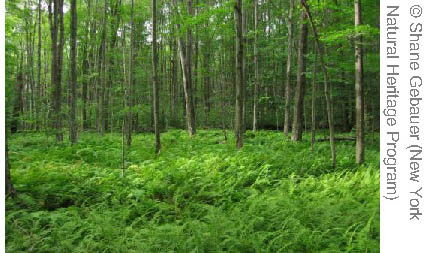

Regional distribution:
NY, PA. 72,645 total acres of habitat, of which 6.9% is conserved.
Description:
A hardwood forest in which American beech and sugar maple make up most of the canopy. Associates can include red oak, basswood, white ash, yellow buckeye, hornbeam, and hop-hornbeam. This forest is characterized by a dense tree canopy that forms a thick layer of humus and leaf litter leading to a rich herbaceous layer, typically including many spring ephemerals. Saplings of canopy trees are often the most abundant component of the shrub layer; other common shrubs include various viburnums, witch hazel, and spicebush. Found primarily along the southern Great Lakes, it is peripheral to our region, occurring only in a small area near Lake Erie. Conversion to agriculture has significantly decreased the range of this system, and very few large stands remain intact.
Download the
pdf for this habitat for information about species, crosswalks to state names, and condition of this habitat.
Glacial Marine & Lake Mesic Clayplain Forest
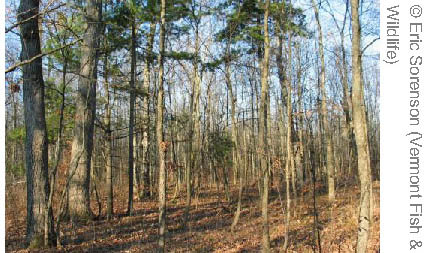

Regional distribution:
NY, VT. 236,851 total acres of habitat, of which 8.0% is conserved.
Description:
A hardwood forest of northern clayplains dominated by a shifting balance of oaks (white, red, swamp white, bur), maples (red and sugar), hemlock and white pine, ash and shagbark hickory, and other associates. The understory herb layer is distinctive and rich, and native and non-native shrubs can be dense. These forests developed on deep clay and silt soils deposited in proglacial lakes and inland seas during late stages of the Northeast's last glaciation. Formerly the dominant ("matrix") forest of the clayplain landscape, the few large tracts of it that survived human settlement are still notably diverse. It is not known to what extent occurrences mapped in northwestern New York (light green) may differ in ecological character from those in the Champlain Valley (dark green).
Download the
pdf for this habitat for information about species, crosswalks to state names, and condition of this habitat.
Appalachian (Hemlock)-Northern Hardwood Forest
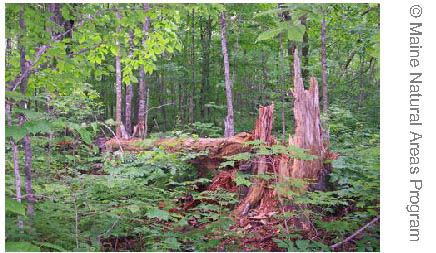

Regional distribution:
CT, DC, DE, MA, MD, ME, NH, NJ, NY, PA, RI, VA, VT, WV. 20,995,362 total acres of habitat, of which 20.1% is conserved.
Description:
A hardwood forest of sugar maple, american beech, and yellow birch, sometimes mixed with, and sometimes dominated by, eastern hemlock. Northern red oak and white oak occur commonly, but do not dominate. Black cherry, black birch, white pine, and tuliptree are typical on nutrient rich or historically disturbed sites. This forest system is broadly defined, and is the only one to occur in at least parts of all 13 states of the Northeast and Mid-Atlantic. It is the dominant forest type in the central and northern part of its range (Allegheny Mountains northward through central New England), and occurs as smaller patches in more protected locations to the south.
Download the
pdf for this habitat for information about species, crosswalks to state names, and condition of this habitat.
Laurentian-Acadian Northern Hardwood Forest
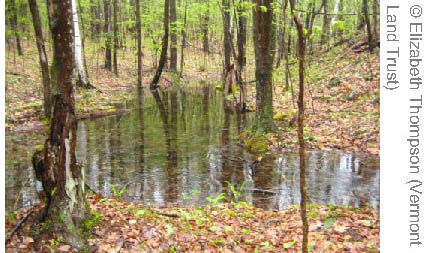

Regional distribution:
CT, MA, ME, NH, NJ, NY, PA, VT. 12,740,118 total acres of habitat, of which 37.8% is conserved.
Description:
A hardwood forest dominated by sugar maple, American beech, and yellow birch; white ash is common on some sites, and hemlock and red spruce are frequent but minor canopy associates. Paper birch, red maple, aspen, and white pine are common in successional stands. This is the "matrix" forest in the northern part of our region, within which upland and wetland systems that occur at smaller scale are embedded. Rich expressions of this habitat type, with herb, shrub, and canopy layers of high diversity, occur over areas of calcium-rich bedrock and in cool, moist sites; forests on acidic till or in areas of granitic (or similar) bedrock are relatively poor floristically. Variability in climate, substrate, and exposure, can lead to stands proportionally higher in conifers or red oak.
Download the
pdf for this habitat for information about species, crosswalks to state names, and condition of this habitat.